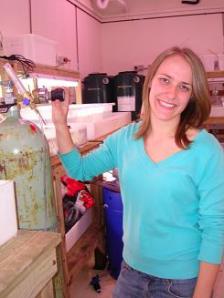 This post is basically a short synopsis of the work done by one of my (now ex-) Ph.D. students, Dr Laura Falkenberg. Laura’s work has turned much of what we thought we knew about the effect of increased CO2 and nutrients on its head; we found synergies where we didn’t expect them (reviewed in a book chapter) and system resilience and resistance to change beyond what we hoped (via strong competitive interaction and trophic links; published in Oecologia, PLoS One and Marine Ecology Progress Series). Laura has certainly helped us look at things in new ways and given us hope that in marine systems where synergies between stressors exist that management of local conditions could potentially buy us some time in mitigating climate change (e.g. reducing nutrient flows into the marine environment, in Journal of Applied Ecology).
This post is basically a short synopsis of the work done by one of my (now ex-) Ph.D. students, Dr Laura Falkenberg. Laura’s work has turned much of what we thought we knew about the effect of increased CO2 and nutrients on its head; we found synergies where we didn’t expect them (reviewed in a book chapter) and system resilience and resistance to change beyond what we hoped (via strong competitive interaction and trophic links; published in Oecologia, PLoS One and Marine Ecology Progress Series). Laura has certainly helped us look at things in new ways and given us hope that in marine systems where synergies between stressors exist that management of local conditions could potentially buy us some time in mitigating climate change (e.g. reducing nutrient flows into the marine environment, in Journal of Applied Ecology).
Ph.D. thesis: Mediation of global change by local biotic and abiotic interactions
by Dr Laura Falkenberg.
Throughout my Ph.D., I assessed the conceptual model that while cross-scale abiotic stressors can combine to synergistically favour shifts in marine habitats from kelp forests to mats of turfing algae, management of local conditions can counter this change. My experimental manipulations found broad support for the hypotheses that; 1) cross-scale factors (i.e. local and global) can have interactive effects which increase the probability of expansion of turfs but not kelp and, 2) management of local conditions (e.g. maintaining intact forests, limiting nutrient enrichment) can dampen the effects of global change (e.g. forecasted carbon dioxide). I published the results from my thesis in four papers. In the first, I showed that experimental enrichment of CO2 and nutrients influence the biomass accumulation of turf and kelp differently, with turf responding positively to enrichment of both resources while kelp responded to enrichment of nutrients but not CO2. Given that such direct responses could be mediated by interactions with other taxa, in the second paper I considered a key competitive interaction and revealed that the presence of kelp can inhibit the synergistic positive effect of resource enrichment (i.e. CO2 and nutrients) on their turf competitors. Similarly, in the third paper I highlighted the importance of herbivory by showing that under enriched CO2 conditions rates of this process were increased to counter the expansion of turfs. Finally, in the fourth paper, I considered a scenario in which these biotic controls were absent and identified that where multiple resources had been enriched and prompted a synergistic response (i.e. the expansion of turf where CO2 and nutrients are modified), subsequent reduction of the locally-determined factor alone (i.e. nutrients) substantially slowed further expansion of turf algae, but that the legacy of nutrient enrichment was not entirely eradicated. Together, these results represent progress in ecological tests of hypotheses regarding global climate change as they incorporate comprehensive sets of abiotic and biotic community drivers.
You can access all of Laura’s publications from the University of Adelaide’s digital library, or email her for a copy.